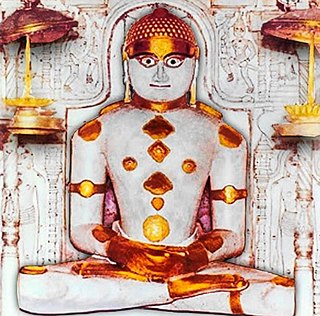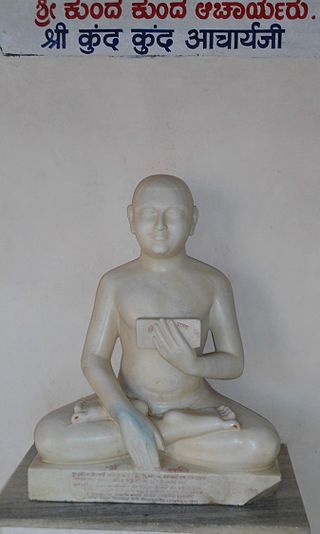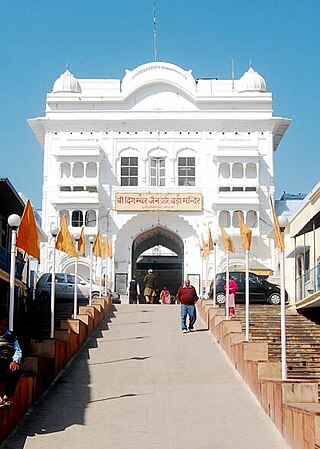
Mahavira, also known as Vardhamana, was the 24th Tirthankara of Jainism. He was the spiritual successor of the 23rd Tirthankara Parshvanatha. Mahavira was born in the early 6th century BCE to a royal Kshatriya Jain family of ancient India. His mother's name was Trishala and his father's name was Siddhartha. According to the second chapter of the Śvētāmbara Ācārāṅga Sūtra, Siddhartha and his family were devotees of Parshvanatha. Mahavira abandoned all worldly possessions at the age of about 30 and left home in pursuit of spiritual awakening, becoming an ascetic. Mahavira practiced intense meditation and severe austerities for twelve and a half years, after which he attained Kevala Jnana (omniscience). He preached for 30 years and attained moksha (liberation) in the 6th century BCE, although the year varies by sect.
Hindu texts or Hindu scriptures are manuscripts and voluminous historical literature which are related to any of the diverse traditions within Hinduism. Some of the major Hindu texts include the Vedas, the Upanishads, and the Itihasa. Scholars hesitate in defining the term "Hindu scriptures" given the diverse nature of Hinduism, but many list the Agamas as Hindu scriptures, and Dominic Goodall includes Bhagavata Purana and Yajnavalkya Smriti in the list of Hindu scriptures as well.

Ādi purāṇa is a 9th-century CE Sanskrit poem composed by Jinasena, a Digambara monk. It deals with the life of Rishabhanatha, the first Tirthankara.

Acharya Jinasena II was a monk and scholar in the Digambara tradition of Jainism. He was patronized by the Rashtrakuta Emperor Amoghavarsha I. He was the author of Adipurana and Mahapurana.

The Padma Purana is one of the eighteen Major Puranas, a genre of texts in Hinduism. It is an encyclopedic text, named after the lotus in which creator god Brahma appeared, and includes large sections dedicated to Vishnu, as well as significant sections on Shiva and Shakti.

The ramanama is the Hindu practice of ritually chanting the name of the deity Rama, an avatar of Vishnu. Rama's name is often chanted or sung within several traditions of Hinduism in the form of a japa, or meditative repetition.

Rishabhanatha, also Rishabhadeva, Rishabha or Ikshvaku, is the first tirthankara of Jainism. He was the first of twenty-four teachers in the present half-cycle of time in Jain cosmology and called a "ford maker" because his teachings helped one cross the sea of interminable rebirths and deaths. The legends depict him as having lived millions of years ago. He was the spiritual successor of Sampratti Bhagwan, the last Tirthankara of the previous time cycle. He is also known as Ādinātha, as well as Adishvara, Yugadideva, Prathamarajeshwara and Nabheya. He is also known as Ikshvaku, establisher of the Ikshvaku dynasty. Along with Mahavira, Parshvanath, Neminath, and Shantinath, Rishabhanatha is one of the five Tirthankaras that attract the most devotional worship among the Jains.

The Buddha is considered the ninth avatar among the ten major avatars of the god Vishnu, according to the Vaishnava tradition of Hinduism.
The Solar dynasty or Sūryavaṃśa, also called the Ikshvaku dynasty, is a legendary Indian dynasty said to have been founded by Ikshvaku. In Hindu literature, it ruled the Kosala Kingdom with their capital at Ayodhya and later at Shravasti. They prayed to their clan deity Surya, after whom the dynasty formed its namesake. Along with the Lunar dynasty, the Solar dynasty comprises one of the main lineages of the Kshatriya varna in Hinduism.
Siddhasēna Divākara was a Jain monk of the Śvetāmbara sect in the fifth century CE who wrote works on Jain philosophy and epistemology. He was like the illuminator of the Jain order and therefore came to be known as Divākara, "Sun". He is credited with the authorship of many books, most of which are not available. Sanmatitarka is the first major Jain work on logic written in Sanskrit. Among the most popular of his works, the Kalyan Mandir Stotra is a Sanskrit hymn dedicated to the 23rd Tirthankara Parshvanatha. It is one of the 9 holiest recitations in the Śvetāmbara Murtipujak sect of Jainism.

Vishnu, also known as Narayana and Hari, is one of the principal deities of Hinduism. He is the supreme being within Vaishnavism, one of the major traditions within contemporary Hinduism.

Rama is a major deity in Hinduism. He is worshipped as the seventh and one of the most popular avatars of Vishnu. In Rama-centric Hindu traditions, he is considered the Supreme Being. Also considered as the ideal man, Rama is the male protagonist of the Hindu epic Ramayana. His birth is celebrated every year on Rama Navami, which falls on the ninth day of the bright half of the lunar cycle of Chaitra (March–April), the first month in the Hindu calendar.

Jain literature refers to the literature of the Jain religion. It is a vast and ancient literary tradition, which was initially transmitted orally. The oldest surviving material is contained in the canonical Jain Agamas, which are written in Ardhamagadhi, a Prakrit language. Various commentaries were written on these canonical texts by later Jain monks. Later works were also written in other languages, like Sanskrit and Maharashtri Prakrit.
Nalini Balbir is a French Indologist who lives in Paris. She is a scholar of Sanskrit, Prakrit, Pali, Jainism, Buddhism and Hinduism. She was previously a student of Indologist Colette Caillat. She is known for her work on the publication of the Catalogue of the Jain Manuscripts of the British Library published by the Institute of Jainology.

Umaswati, also spelled as Umasvati and known as Umaswami, was an Indian scholar, possibly between 2nd-century and 5th-century CE, known for his foundational writings on Jainism. He authored the Jain text Tattvartha Sutra. According to historian Moriz Winternitz, Umaswati may have been a Śvetāmbara ascetic as his views correspond more with the Śvetāmbara sect than with the Digambara sect, and that the latter is 'hardly entitled to claim him.' Umaswati's work was the first Sanskrit language text on Jain philosophy, and is the earliest extant comprehensive Jain philosophy text accepted as authoritative by all four Jain traditions. His text has the same importance in Jainism as Vedanta Sutras and Yogasutras have in Hinduism.

Digambara is one of the two major schools of Jainism, the other being Śvetāmbara (white-clad). The Sanskrit word Digambara means "sky-clad", referring to their traditional monastic practice of neither possessing nor wearing any clothes.
Jainism and Hinduism are two ancient Indian religions. There are some similarities and differences between the two religions. Temples, gods, rituals, fasts and other religious components of Jainism are different from those of Hinduism.
Samudravijaya was the father of Neminatha and brother of Vasudeva. He was born to King Andhakavṛṣṭī of Harivamsa dynasty in Śaurīpura where he later ruled as a king. He married princess Shivadevi.

Digamber Jain Bada Mandir Hastinapur is a Jain temple complex located in Hastinapur, Uttar Pradesh. It is the oldest Jain temple in Hastinapur dedicated to Shantinatha, the 16th Jain Tirthankara.
Vimalsuri was a Jain monk of the Śvetāmbara Murtipujaka sect. He is best known for his composition "Paumachariyam", the earliest known Jain version of the Ramayana and the oldest work of literature written in Maharashtri Prakrit. Although scholars' opinion and traditional beliefs differ on his timeline, the common belief is that he lived between the 1st and the 3rd century AD.














